Deep in the desert outside Jodhpur, the turbaned man sat silently on the floor. He worked methodically, crushing paste and funnelling liquid until the strange concoction was eventually ready. He poured some into the palm of his leathery hand and raised it towards my mouth. Obediently, I lowered my lips and sipped the sepia-coloured brew. My first taste of opium.
I knew I was in safe hands though. Drinking this heavily diluted form of the drug has been a way of life for the Bishnoi tribe of Rajasthan for centuries, with the authorities turning a blind eye to the illegal but age-old custom.
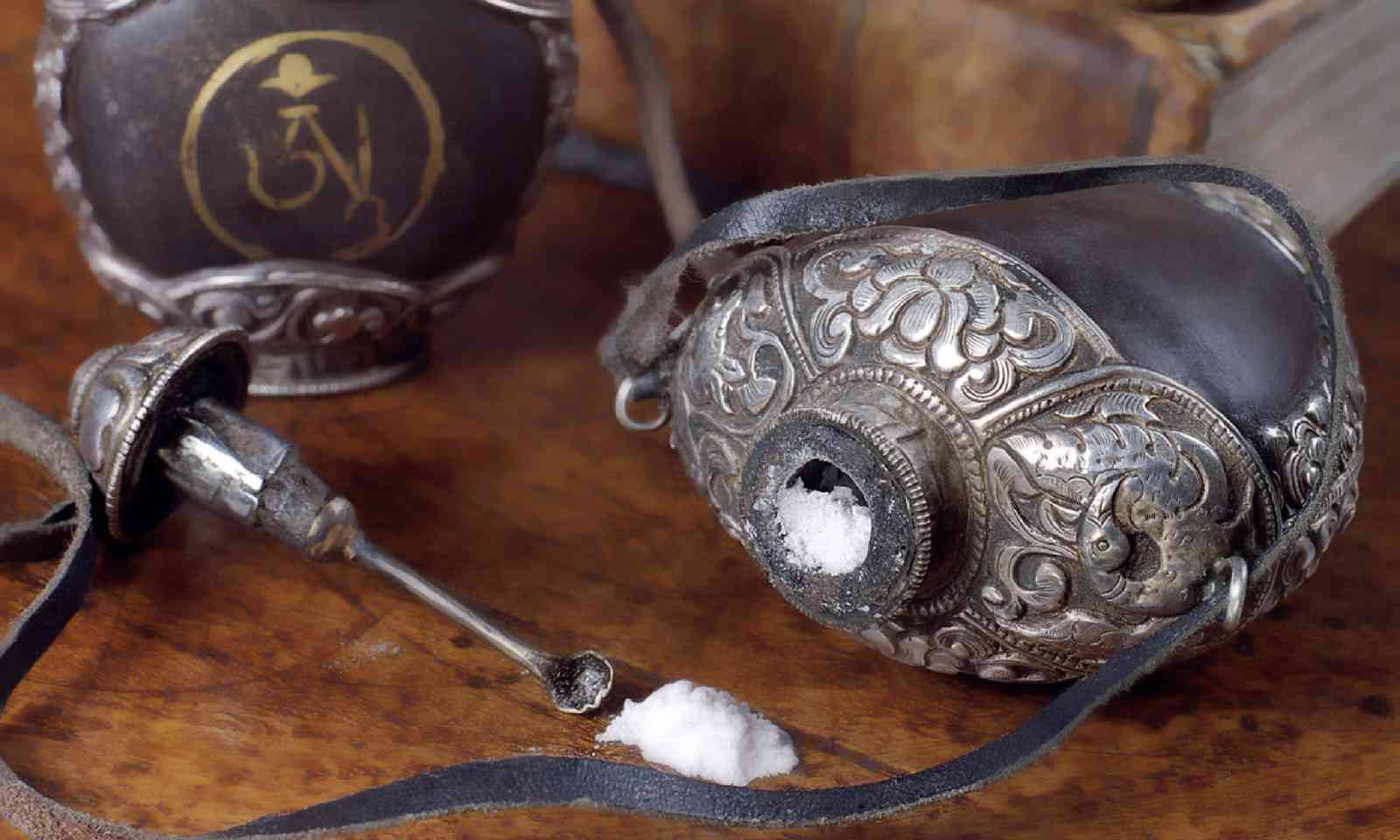
Opium, India (Shutterstock)
Keeping a watchful eye were the guides from the Maharajas’ Express, India’s most luxurious train. We were halfway through our seven-night cross-country adventure on the subcontinent’s answer to the Orient Express, a journey of more than 3,200km that took us from Mumbai to Delhi via lavish palaces, historic forts, remote tribal villages, wildlife refuges and iconic wonders of the world.
The train’s attentive valets (every cabin gets its own butler, naturally) formed a long line beside the navy and burgundy carriages. Each wearing red turbans and white jodhpur trousers, they stood with their hands pressed together, bowing their heads in a traditional namaste greeting.
Over a glass of sparkling wine, I got to know some of my fellow passengers. For most of them, this trip was at the very top of their bucket list. One pair – a retired couple from Western Australia – were here to fulfil a lifelong dream. “We’ll be paying this off for years but it’s a real once-in-a-lifetime journey,” said Aussie Ann.
Yes, a trip on the Maharajas’ Express – travelling on tracks first laid by India’s regional royalty so they could tour their territories on toy trains – does not come cheaply. The carriage-long Presidential Suite costs upwards of £15,000 yet the train, which can accommodate 88 people, still remains popular with those wanting a whistle-stop tour of India’s big highlights without sacrificing on comfort.
Think silk blinds, marble floors, carved wooden panels and cabins with comfy beds and private bathrooms. The food? It’s better than most restaurants, with regional specialities – everything from Punjabi to Kashmiri dishes – served on gold-plated crockery. The phrase ‘roughing it’ does not exist anywhere near this locomotive.
Suffice to say, it was a far cry from my previous experience of travelling by rail in India, going from Delhi to Varanasi on a crowded local train – a stressful but special journey. I wondered how it would compare.
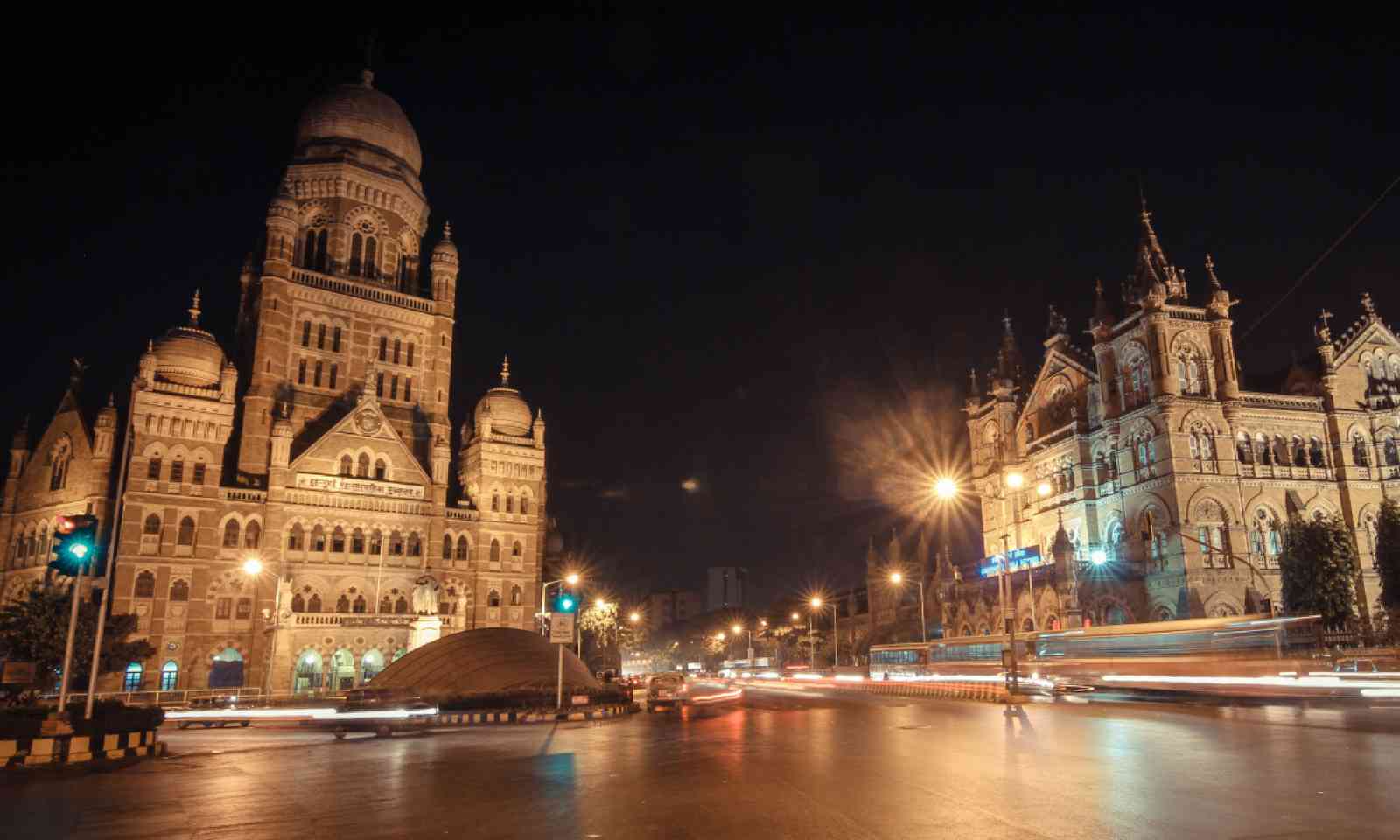
Mumbai (Shutterstock)
Our first overnight journey took us north-east towards the ancient rock-cut Buddhist caves of Ajanta. I fell asleep to the soothing motion of the train; I was woken by a gentle knock at the door and an early morning cup of tea, delivered by my laconic valet Gaurav.
I opened the blinds and sat sipping tea in bed as the Indian countryside rolled past the window: endless cotton fields, and villages of small huts with pointy straw roofs that looked like lopsided witches’ hats. Orange scarves tied around scarecrows billowed in the breeze; men washed in rivers as the women, dressed in paprika-red veils, carried steel pots on their heads.
After another red carpet arrival at Pachora Junction, we were herded onto waiting coaches and taken to the Ajanta Caves, 30 cave-monuments carved in a large semi-circle overlooking a lush gorge and the slow-flowing River Waghora (Tiger River). First created in the second century BC, Ajanta was once a place of refuge and spiritual reflection. I walked inside, the cool air a heavenly escape from the Indian sun, and gazed up at the faded frescoes painted by Buddhist monks.
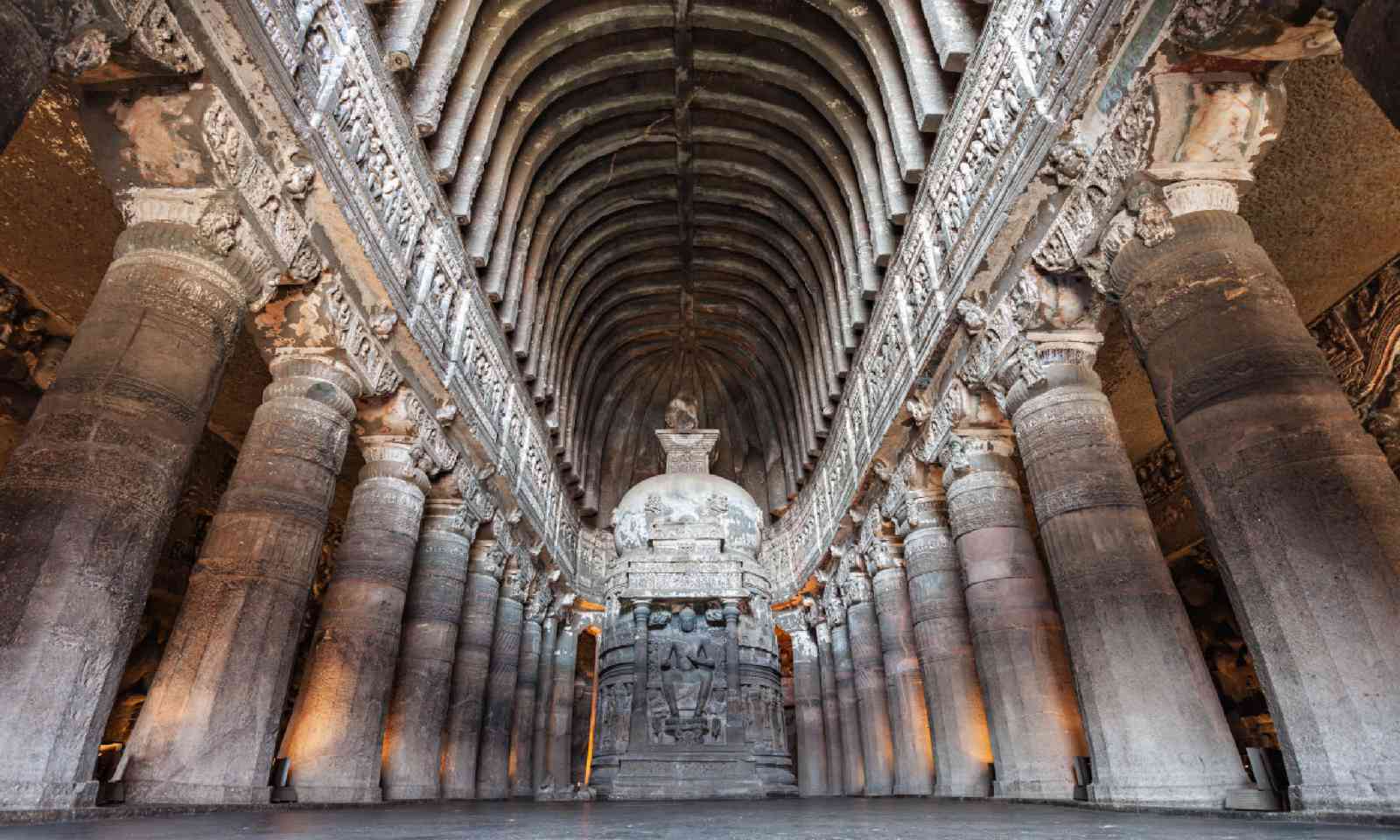
Ajanta caves near Aurangabad (Shutterstock)
My favourite piece, however, was outside cave number four. The stone sculpture of the deity Avalokiteśvara – the protector of travellers, perhaps an exotic cousin of St Christopher – was surrounded by carvings depicting the perils of early exploration in India: rampaging elephants, biting cobras, thieves, being sacrificed on burning fires…
Of course, the greatest concern facing me on this particular journey was whether to choose the safed maans (Rajasthani chicken cooked in yoghurt) or the paneer laung latta (cottage cheese in a tomato gravy) for dinner back on the train.
Travelling in such fine surroundings was an experience to savour but not one that came without a degree of discomfort. Staring out from such opulence onto scenes of abject poverty did not sit easily. However, onboard tour guide, Prince, was quick to explore the issue.
“It’s a very uncomfortable situation but India is a young country and things are improving,” he said as we pulled alongside a local express train crammed to the rafters with passengers, some hanging out of the open doors and peering from behind the barred windows. I wondered what they must think of these rich foreigners living in the lap of luxury. Resentment? Intrigue? Anger? “No,” said Prince. “They see it as aspirational. If they felt anger, they would throw stones at the train.”
The train certainly attracted interest wherever it went but never any hostility. In stations, where cows meandered down the platforms, curious locals wandered up and peered through the glass. They smiled and waved and blew kisses.
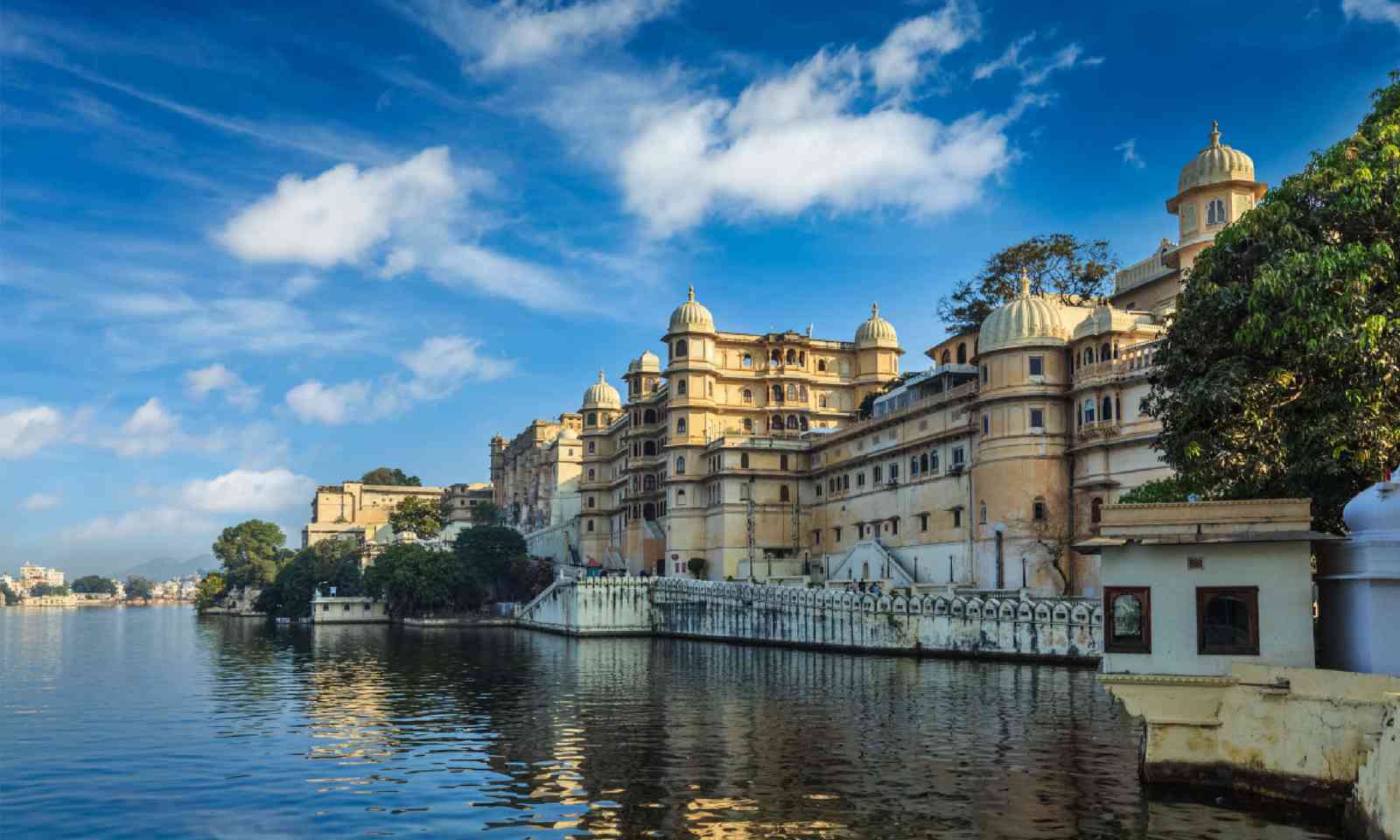
Udaipur City Palace and Lake Pichola (Shutterstock)
In 1730, 363 members of this gentle tribe lost their heads – not to opium but to sharp swords. In an attempt to save a forest from destruction, the Bishnoi wrapped their arms around the trunks, but were decapitated by the king’s men. The shamed maharaja of nearby Jodhpur heard about the massacre and ordered an immediate stop to the deforestation. Today, the Bishnoi enjoy a privileged existence, with the authorities allowing their controversial – and illegal – habits to continue.
In the village, water buffalos were slumped in the shade of lemon trees and the smell of cattle hung over the compound of small huts. Inside one hut was Koshliya, a demur young woman who moved here from a neighbouring Bishnoi tribe. Stationed by the stove, she kept a close eye on the shimmering milky masala chai infused with fragrant cardamom and ginger. “Women are not allowed opium, so it’s chai for us,” she laughed.
Outside, the chief of the tribe was busy tending to his opium. Wearing white robes and a matching turban – a sign of peace – Tulsa took a piece of the dark-coloured sap and mixed it with water, crushing it methodically to create a paste that he fed into a wooden contraption. Part filter, part shrine, this apparatus featured a tiny model of Shiva above two conical funnels made of camel wool, into which Tulsa carefully poured the murky mixture. It seeped through the pointy bottom drop by drop, slowly filling an ornate cup.
He called me forwards and I joined him, sitting cross-legged on a mat on the floor. Before serving up, Tulsa sprinkled droplets over the shrine to Shiva and recited a Hindu prayer, the holy words shooting from his mouth with the speed and ferocity of a machine gun.
As is customary, guests must cover their heads before accepting the opium-laced beverage. Tulsa reached across and placed a technicolor turban snugly on my head before pouring the bitter tonic into the palm of his hand, from which I sipped – another Bishnoi tradition.
After three mouthfuls I sat up, waiting for some kind of affect to take hold – perhaps sensations of complete calm or even a slight light-headedness. But nothing. Heavily diluted for the uninitiated, the Bishnoi’s brew is essentially harmless. More tangy than trippy.
“My first taste of opium was as a young boy with my friends,” said Tulsa wistfully. “It’s an important part of our culture. We are a small community and opium is a bond that unites us together.”
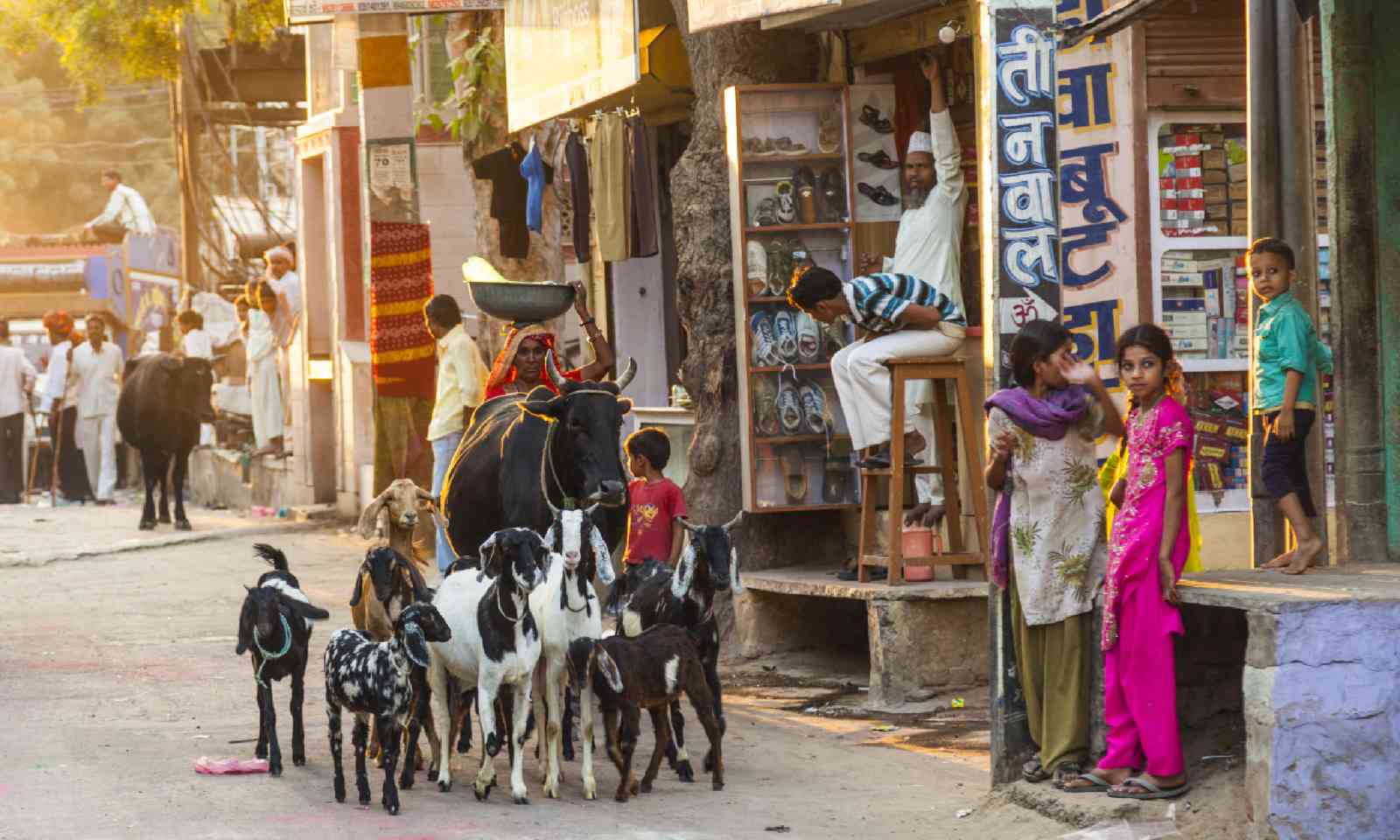
Jodhpur bazaar (Shutterstock)
Camels, rickshaws, trucks and buses swarmed outside the central bazaar. Inside, the narrow pathways of the market were heaving with housewives closely inspecting the fresh produce on display. Motorbikes and goats squeezed past them with loud beeps and shrill bleats. Elsewhere, stall vendors called out, hopeful of selling their 80 varieties of rice to anyone passing by. I saw a chocolate-coloured bull sauntering past one fruit and vegetable stand; it swiped a big mouthful of green beans, causing the seller to leap to his feet and shoo the hoofed offender away – with the utmost respect, of course.
It was as thrilling as it was overwhelming – just what travel in India should be. But soon it was back to the comfort and calmness of the train. The valets were waiting with cold towels and fruity mocktails that we enjoyed from the plush leather sofas of the bar. Everyone took stock of the day, marvelling at the madness of this most crazy of countries and exchanging tales of the strange sights beheld.
My mind, however, drifted elsewhere. As the train lurched into motion, heading north-east towards the city of Bikaner, it was time to contemplate what awaited the next morning: a visit to the legendary Karni Mata temple. Home to 20,000 rats, deemed holy, it’s not a place for the faint of heart.
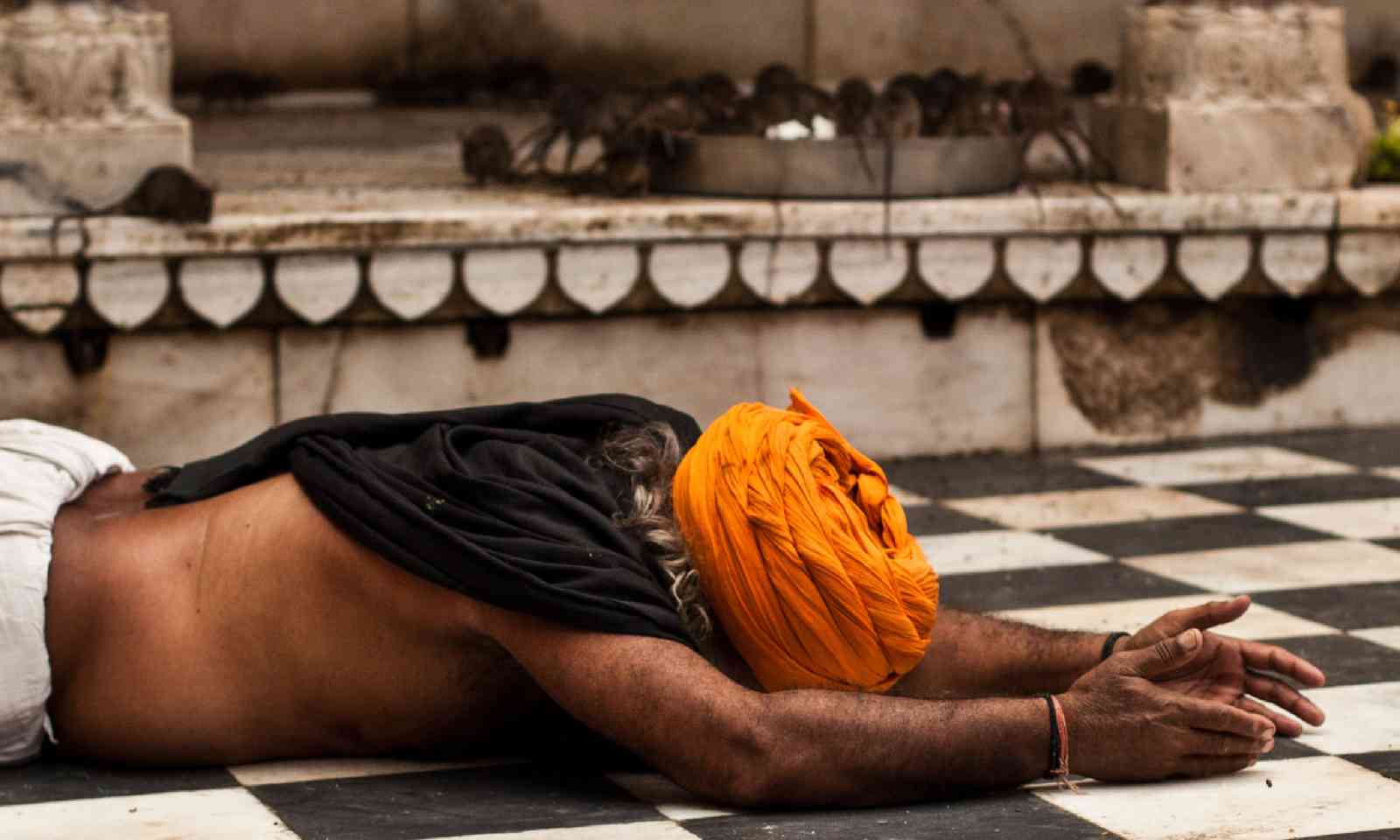
Karni Mata Temple (Shutterstock) – note the rats in the background!!
I’m not good with rodents, no matter how revered they may be. Removing my shoes, I gingerly entered the ornate complex feeling as though I was tackling some sort of Bushtucker Trial. The rats scurried all over the place: across the checked floor, up the drainpipes, in cupboards, on shrines, around worshippers deep in prayer.
Most of the animals congregated around large bowls of milk that had been placed on the floor, clamouring over each other for a sip, all twitching noses and wriggling tails. Among the hundreds of black rats, I could see a single white one, and devotees fought to catch a glimpse – it’s considered a blessing. I left them to it, making a hasty exit.
Aside from up-close encounters of the vermin kind, one of the most significant benefits of travelling on the Maharajas’ Express is the extraordinary access it allows to places usually off-limits. In Jaipur, India’s Pink City, the doors to the private living quarters of the ‘royal family’ were thrown open just for us.
In the drawing room, where crystal chandeliers hung from the high ceiling, dozens of framed family photos were on display. Nothing unusual about that – except that this family was mostly posing beside royalty and heads of state. Taken just yards away from where I was standing, the snapshots featured a range of famous friends, including the Clintons and Prince Charles with Princess Diana; curiously, right beside that photo was another of Charles, taken years later, with Camilla.
While they still enjoy a blessed existence, the maharajas of India got a rude awakening in 1971 when Prime Minister Indira Gandhi stripped them of their powers after years of extravagant rule; however, many were permitted to keep their sprawling estates.
A dawn chill lingered over Ranthambore National Park. We wrapped up against the cold in fleeces and blankets as our open-top jeep powered along the reserve’s bumpy tracks on the lookout for its most famous resident: the royal Bengal tiger. Once the private hunting estate of trigger-happy maharajas, Ranthambore became a Project Tiger reserve in 1973 and is now though to be home to around 60 of the critically endangered felines.
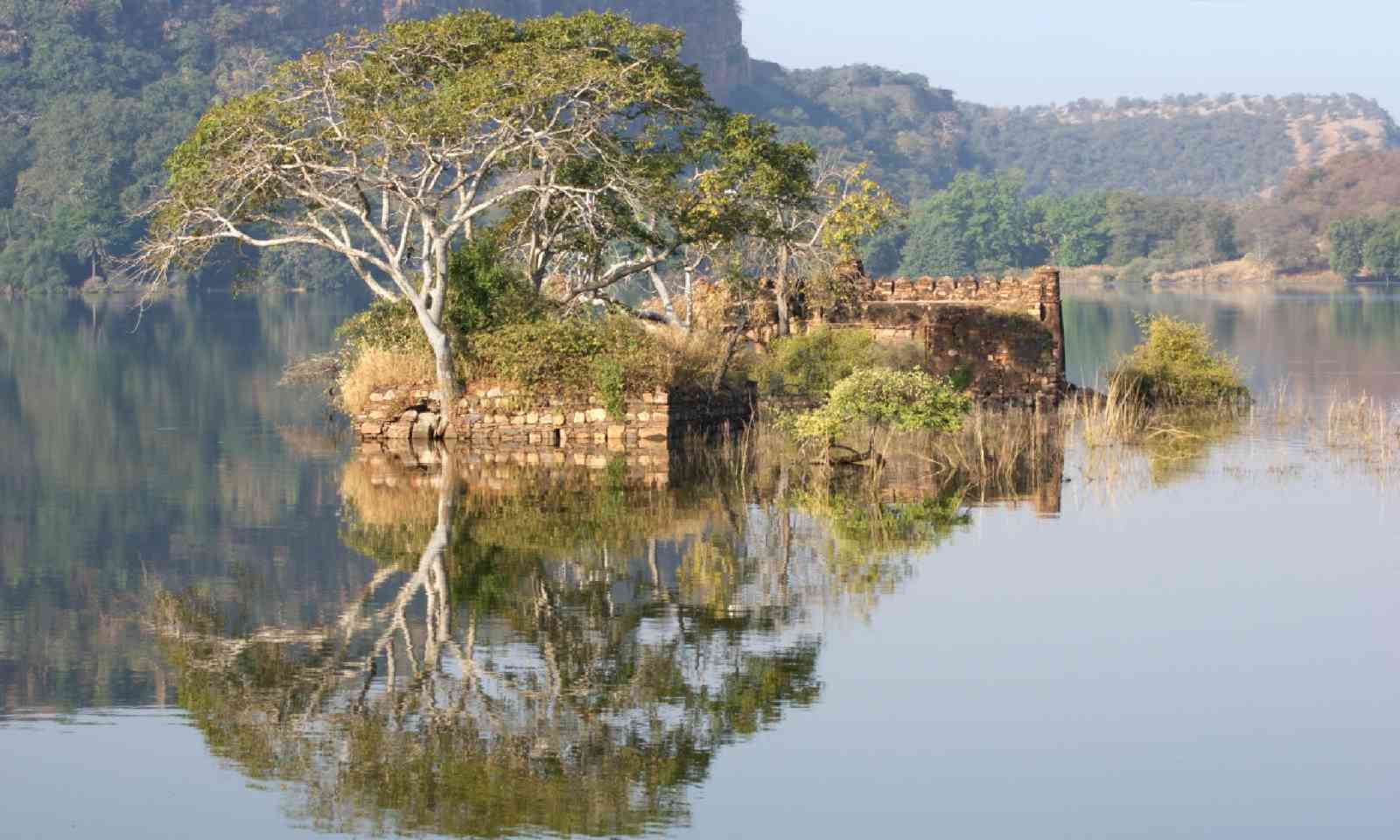
Ranthambore National Park (Shutterstock)
But the solitary creatures are notoriously difficult to spot and with time for only one short game drive, the odds were against us. Still, local wildlife guide Ajay remained positive. “We will try. I usually see tigers every two or three days,” he said. Over his shoulder stood the decaying remains of the ancient fort from which the park gets its name. Long before the maharajas came along, the forest was home to the indigenous Minas tribe, known for marking the forehead of their rulers with blood from somebody’s toe or thumb.
All eyes scanned the dense woods and bushland, hopeful of spotting a striped tail or pair of piercing amber eyes. Peacocks settled in the shade of colossal 300-year-old banyan trees while monkeys somersaulted in the branches.
Hopes were raised when the morning calm was shattered by the loud alarm call of a spotted deer: a tell-tell sign of a lurking tiger, according to Ajay. Perched by a rocky embankment, the jeep’s engine fell silent and we waited with bated breath. The seconds rolled into minutes but the only sign of movement came from a mongoose scurrying in the undergrowth.
The disappointment was shortlived as we pressed onwards towards Agra and India’s most fabled monument, the most fabulous ‘final stop’ on the planet. “For almost everybody, this is the most anticipated stage of the whole journey,” said Prince. All our conversations came to an abrupt end as the white-marble dome of the Taj Mahal, basking in the warm rosy glow of sunrise, came into view.
Goosebumps crept along my arms, one hair at a time. More than 20 years in the making, by a task force of 20,000 men, the Taj is the ultimate monument to eternal love. It was built in the mid-17th century by order of a grief-stricken emperor wanting to create a final resting place for his late wife. Footsteps echoed around the darkened mausoleum. Amid the intricate floral carvings and verses of Persian poetry on the walls stood two tombs: that of Emperor Jahan and his beloved Mumtaz Mahal.
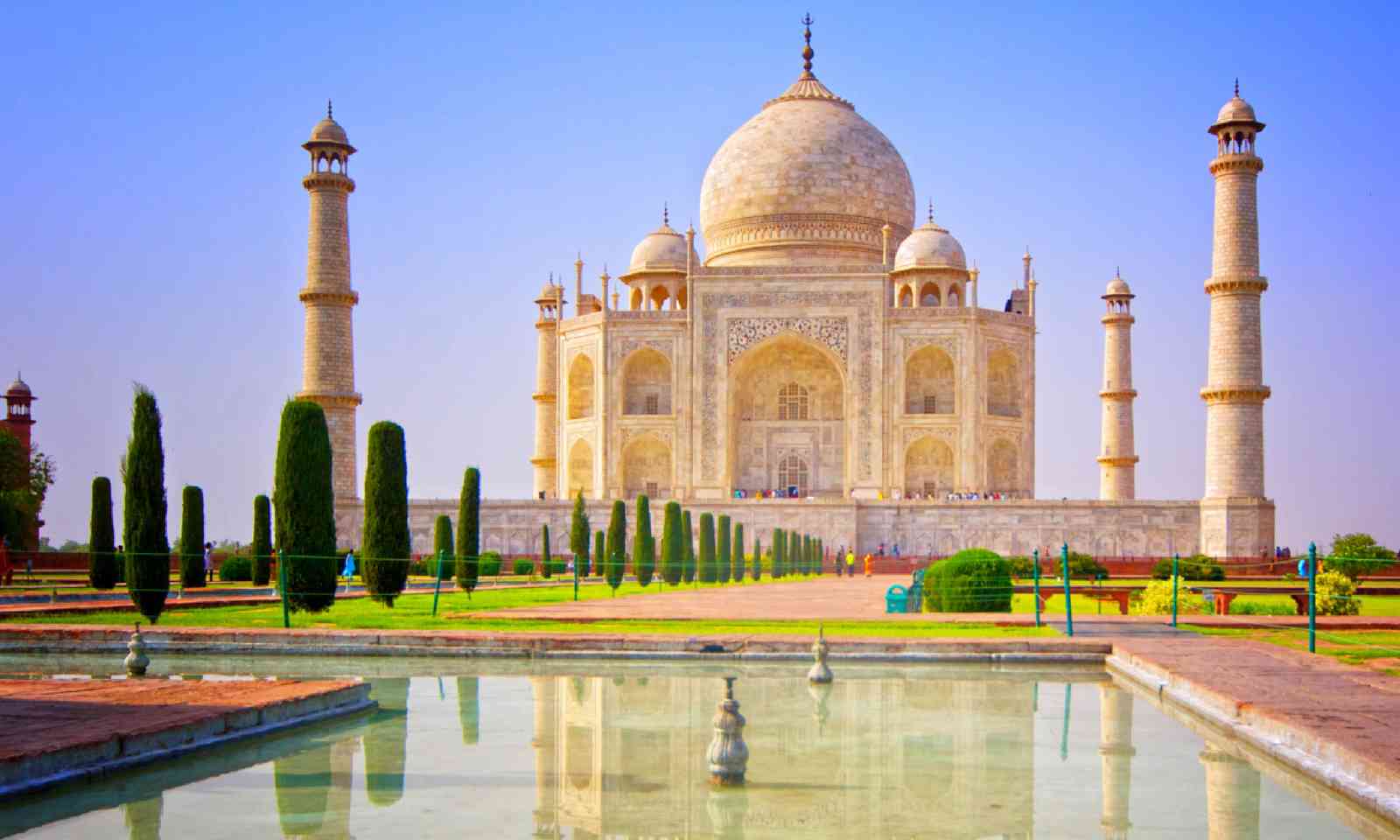
Taj Mahal (Shutterstock)
Outside, crowds gathered around the colourful flowerbeds and spouting water fountains to take in the sheer majesty. My fellow train passengers and I may have arrived in Agra in the utmost luxury but here, in this very moment, it mattered not. As we stood amid everyone from scruffy backpackers to big Indian families, we were all united in appreciation of the magnificence before us – a bucket-list topper, no matter how you get to it.
“I’ve seen the Taj more than 100 times but I never tire of its beauty,” beamed Prince, gazing across at the marbled masterpiece. “Everyone should see it at least once in their lifetime.”
The author travelled with specialist train tour operator Railbookers, which offers an eight-night Maharajas’ Express Heritage of India Mumbai-Delhi train trip. A three-night Maharajas’ Express Gems of India option includes train travel from Delhi to Agra, Ranthambore, Jaipur, and back to Delhi.
Main image: Jodhpur, Rajasthan, India (Shutterstock)
I knew I was in safe hands though. Drinking this heavily diluted form of the drug has been a way of life for the Bishnoi tribe of Rajasthan for centuries, with the authorities turning a blind eye to the illegal but age-old custom.

Opium, India (Shutterstock)
Keeping a watchful eye were the guides from the Maharajas’ Express, India’s most luxurious train. We were halfway through our seven-night cross-country adventure on the subcontinent’s answer to the Orient Express, a journey of more than 3,200km that took us from Mumbai to Delhi via lavish palaces, historic forts, remote tribal villages, wildlife refuges and iconic wonders of the world.
All aboard
We boarded with a fanfare that attracted a crowd of curious locals, all trying to push and tiptoe their way to the front. A brass band played loudly as us passengers queued for fragrant garlands to be placed around our necks and scarlet bindis to be dotted on our foreheads.The train’s attentive valets (every cabin gets its own butler, naturally) formed a long line beside the navy and burgundy carriages. Each wearing red turbans and white jodhpur trousers, they stood with their hands pressed together, bowing their heads in a traditional namaste greeting.
Over a glass of sparkling wine, I got to know some of my fellow passengers. For most of them, this trip was at the very top of their bucket list. One pair – a retired couple from Western Australia – were here to fulfil a lifelong dream. “We’ll be paying this off for years but it’s a real once-in-a-lifetime journey,” said Aussie Ann.
Yes, a trip on the Maharajas’ Express – travelling on tracks first laid by India’s regional royalty so they could tour their territories on toy trains – does not come cheaply. The carriage-long Presidential Suite costs upwards of £15,000 yet the train, which can accommodate 88 people, still remains popular with those wanting a whistle-stop tour of India’s big highlights without sacrificing on comfort.
Think silk blinds, marble floors, carved wooden panels and cabins with comfy beds and private bathrooms. The food? It’s better than most restaurants, with regional specialities – everything from Punjabi to Kashmiri dishes – served on gold-plated crockery. The phrase ‘roughing it’ does not exist anywhere near this locomotive.
Suffice to say, it was a far cry from my previous experience of travelling by rail in India, going from Delhi to Varanasi on a crowded local train – a stressful but special journey. I wondered how it would compare.
Pulling out the stops
The Maharajas’ Express – all half a mile of it – rattled out of Mumbai’s Chhatrapati Shivaji station late afternoon on a Friday. Dissecting the city’s sprawling suburbs – a blur of slums and skyscrapers – it sped past stations with packed platforms, including the aptly named Currey Road.
Mumbai (Shutterstock)
Our first overnight journey took us north-east towards the ancient rock-cut Buddhist caves of Ajanta. I fell asleep to the soothing motion of the train; I was woken by a gentle knock at the door and an early morning cup of tea, delivered by my laconic valet Gaurav.
I opened the blinds and sat sipping tea in bed as the Indian countryside rolled past the window: endless cotton fields, and villages of small huts with pointy straw roofs that looked like lopsided witches’ hats. Orange scarves tied around scarecrows billowed in the breeze; men washed in rivers as the women, dressed in paprika-red veils, carried steel pots on their heads.
After another red carpet arrival at Pachora Junction, we were herded onto waiting coaches and taken to the Ajanta Caves, 30 cave-monuments carved in a large semi-circle overlooking a lush gorge and the slow-flowing River Waghora (Tiger River). First created in the second century BC, Ajanta was once a place of refuge and spiritual reflection. I walked inside, the cool air a heavenly escape from the Indian sun, and gazed up at the faded frescoes painted by Buddhist monks.

Ajanta caves near Aurangabad (Shutterstock)
My favourite piece, however, was outside cave number four. The stone sculpture of the deity Avalokiteśvara – the protector of travellers, perhaps an exotic cousin of St Christopher – was surrounded by carvings depicting the perils of early exploration in India: rampaging elephants, biting cobras, thieves, being sacrificed on burning fires…
Of course, the greatest concern facing me on this particular journey was whether to choose the safed maans (Rajasthani chicken cooked in yoghurt) or the paneer laung latta (cottage cheese in a tomato gravy) for dinner back on the train.
Travelling in such fine surroundings was an experience to savour but not one that came without a degree of discomfort. Staring out from such opulence onto scenes of abject poverty did not sit easily. However, onboard tour guide, Prince, was quick to explore the issue.
“It’s a very uncomfortable situation but India is a young country and things are improving,” he said as we pulled alongside a local express train crammed to the rafters with passengers, some hanging out of the open doors and peering from behind the barred windows. I wondered what they must think of these rich foreigners living in the lap of luxury. Resentment? Intrigue? Anger? “No,” said Prince. “They see it as aspirational. If they felt anger, they would throw stones at the train.”
The train certainly attracted interest wherever it went but never any hostility. In stations, where cows meandered down the platforms, curious locals wandered up and peered through the glass. They smiled and waved and blew kisses.

Udaipur City Palace and Lake Pichola (Shutterstock)
High class
After a lovely day in majestic Udaipur, exploring its lakes and forts, it was onwards to visit the Bishnoi. The name of this sect is a colloquial word meaning ‘29’, which refers to the number of sacred principles they follow. Strictly vegetarian – with a strong love of opium – the Bishnoi are the only Hindus that bury their dead; they are also known to breast-feed deer and hug trees.In 1730, 363 members of this gentle tribe lost their heads – not to opium but to sharp swords. In an attempt to save a forest from destruction, the Bishnoi wrapped their arms around the trunks, but were decapitated by the king’s men. The shamed maharaja of nearby Jodhpur heard about the massacre and ordered an immediate stop to the deforestation. Today, the Bishnoi enjoy a privileged existence, with the authorities allowing their controversial – and illegal – habits to continue.
In the village, water buffalos were slumped in the shade of lemon trees and the smell of cattle hung over the compound of small huts. Inside one hut was Koshliya, a demur young woman who moved here from a neighbouring Bishnoi tribe. Stationed by the stove, she kept a close eye on the shimmering milky masala chai infused with fragrant cardamom and ginger. “Women are not allowed opium, so it’s chai for us,” she laughed.
Outside, the chief of the tribe was busy tending to his opium. Wearing white robes and a matching turban – a sign of peace – Tulsa took a piece of the dark-coloured sap and mixed it with water, crushing it methodically to create a paste that he fed into a wooden contraption. Part filter, part shrine, this apparatus featured a tiny model of Shiva above two conical funnels made of camel wool, into which Tulsa carefully poured the murky mixture. It seeped through the pointy bottom drop by drop, slowly filling an ornate cup.
He called me forwards and I joined him, sitting cross-legged on a mat on the floor. Before serving up, Tulsa sprinkled droplets over the shrine to Shiva and recited a Hindu prayer, the holy words shooting from his mouth with the speed and ferocity of a machine gun.
As is customary, guests must cover their heads before accepting the opium-laced beverage. Tulsa reached across and placed a technicolor turban snugly on my head before pouring the bitter tonic into the palm of his hand, from which I sipped – another Bishnoi tradition.
After three mouthfuls I sat up, waiting for some kind of affect to take hold – perhaps sensations of complete calm or even a slight light-headedness. But nothing. Heavily diluted for the uninitiated, the Bishnoi’s brew is essentially harmless. More tangy than trippy.
“My first taste of opium was as a young boy with my friends,” said Tulsa wistfully. “It’s an important part of our culture. We are a small community and opium is a bond that unites us together.”

Jodhpur bazaar (Shutterstock)
Conscience calling
Back on board the train, having been festooned with another garland, lunch was served before an afternoon spent exploring Jodhpur. Something was niggling me, a growing frustration at how we were being sheltered from the ‘real India’ by being ferried around in air-conditioned coaches. But, finally, in Jodhpur we were thrown into the thick of the action as we sped through the cattle-clogged streets in a convoy of green-and-yellow tuk-tuks.Camels, rickshaws, trucks and buses swarmed outside the central bazaar. Inside, the narrow pathways of the market were heaving with housewives closely inspecting the fresh produce on display. Motorbikes and goats squeezed past them with loud beeps and shrill bleats. Elsewhere, stall vendors called out, hopeful of selling their 80 varieties of rice to anyone passing by. I saw a chocolate-coloured bull sauntering past one fruit and vegetable stand; it swiped a big mouthful of green beans, causing the seller to leap to his feet and shoo the hoofed offender away – with the utmost respect, of course.
It was as thrilling as it was overwhelming – just what travel in India should be. But soon it was back to the comfort and calmness of the train. The valets were waiting with cold towels and fruity mocktails that we enjoyed from the plush leather sofas of the bar. Everyone took stock of the day, marvelling at the madness of this most crazy of countries and exchanging tales of the strange sights beheld.
My mind, however, drifted elsewhere. As the train lurched into motion, heading north-east towards the city of Bikaner, it was time to contemplate what awaited the next morning: a visit to the legendary Karni Mata temple. Home to 20,000 rats, deemed holy, it’s not a place for the faint of heart.

Karni Mata Temple (Shutterstock) – note the rats in the background!!
I’m not good with rodents, no matter how revered they may be. Removing my shoes, I gingerly entered the ornate complex feeling as though I was tackling some sort of Bushtucker Trial. The rats scurried all over the place: across the checked floor, up the drainpipes, in cupboards, on shrines, around worshippers deep in prayer.
Most of the animals congregated around large bowls of milk that had been placed on the floor, clamouring over each other for a sip, all twitching noses and wriggling tails. Among the hundreds of black rats, I could see a single white one, and devotees fought to catch a glimpse – it’s considered a blessing. I left them to it, making a hasty exit.
Aside from up-close encounters of the vermin kind, one of the most significant benefits of travelling on the Maharajas’ Express is the extraordinary access it allows to places usually off-limits. In Jaipur, India’s Pink City, the doors to the private living quarters of the ‘royal family’ were thrown open just for us.
In the drawing room, where crystal chandeliers hung from the high ceiling, dozens of framed family photos were on display. Nothing unusual about that – except that this family was mostly posing beside royalty and heads of state. Taken just yards away from where I was standing, the snapshots featured a range of famous friends, including the Clintons and Prince Charles with Princess Diana; curiously, right beside that photo was another of Charles, taken years later, with Camilla.
While they still enjoy a blessed existence, the maharajas of India got a rude awakening in 1971 when Prime Minister Indira Gandhi stripped them of their powers after years of extravagant rule; however, many were permitted to keep their sprawling estates.
Tiger, tiger
The trip was fast coming to an end but two of the most anticipated elements were yet to come: tigers and the Taj.A dawn chill lingered over Ranthambore National Park. We wrapped up against the cold in fleeces and blankets as our open-top jeep powered along the reserve’s bumpy tracks on the lookout for its most famous resident: the royal Bengal tiger. Once the private hunting estate of trigger-happy maharajas, Ranthambore became a Project Tiger reserve in 1973 and is now though to be home to around 60 of the critically endangered felines.

Ranthambore National Park (Shutterstock)
But the solitary creatures are notoriously difficult to spot and with time for only one short game drive, the odds were against us. Still, local wildlife guide Ajay remained positive. “We will try. I usually see tigers every two or three days,” he said. Over his shoulder stood the decaying remains of the ancient fort from which the park gets its name. Long before the maharajas came along, the forest was home to the indigenous Minas tribe, known for marking the forehead of their rulers with blood from somebody’s toe or thumb.
All eyes scanned the dense woods and bushland, hopeful of spotting a striped tail or pair of piercing amber eyes. Peacocks settled in the shade of colossal 300-year-old banyan trees while monkeys somersaulted in the branches.
Hopes were raised when the morning calm was shattered by the loud alarm call of a spotted deer: a tell-tell sign of a lurking tiger, according to Ajay. Perched by a rocky embankment, the jeep’s engine fell silent and we waited with bated breath. The seconds rolled into minutes but the only sign of movement came from a mongoose scurrying in the undergrowth.
The disappointment was shortlived as we pressed onwards towards Agra and India’s most fabled monument, the most fabulous ‘final stop’ on the planet. “For almost everybody, this is the most anticipated stage of the whole journey,” said Prince. All our conversations came to an abrupt end as the white-marble dome of the Taj Mahal, basking in the warm rosy glow of sunrise, came into view.
Goosebumps crept along my arms, one hair at a time. More than 20 years in the making, by a task force of 20,000 men, the Taj is the ultimate monument to eternal love. It was built in the mid-17th century by order of a grief-stricken emperor wanting to create a final resting place for his late wife. Footsteps echoed around the darkened mausoleum. Amid the intricate floral carvings and verses of Persian poetry on the walls stood two tombs: that of Emperor Jahan and his beloved Mumtaz Mahal.

Taj Mahal (Shutterstock)
Outside, crowds gathered around the colourful flowerbeds and spouting water fountains to take in the sheer majesty. My fellow train passengers and I may have arrived in Agra in the utmost luxury but here, in this very moment, it mattered not. As we stood amid everyone from scruffy backpackers to big Indian families, we were all united in appreciation of the magnificence before us – a bucket-list topper, no matter how you get to it.
“I’ve seen the Taj more than 100 times but I never tire of its beauty,” beamed Prince, gazing across at the marbled masterpiece. “Everyone should see it at least once in their lifetime.”
The author travelled with specialist train tour operator Railbookers, which offers an eight-night Maharajas’ Express Heritage of India Mumbai-Delhi train trip. A three-night Maharajas’ Express Gems of India option includes train travel from Delhi to Agra, Ranthambore, Jaipur, and back to Delhi.
Main image: Jodhpur, Rajasthan, India (Shutterstock)


